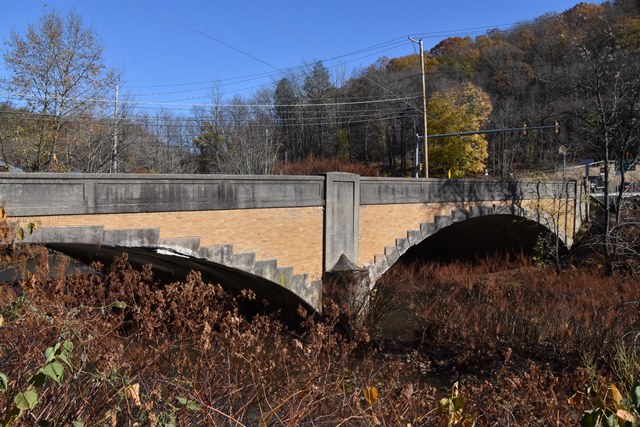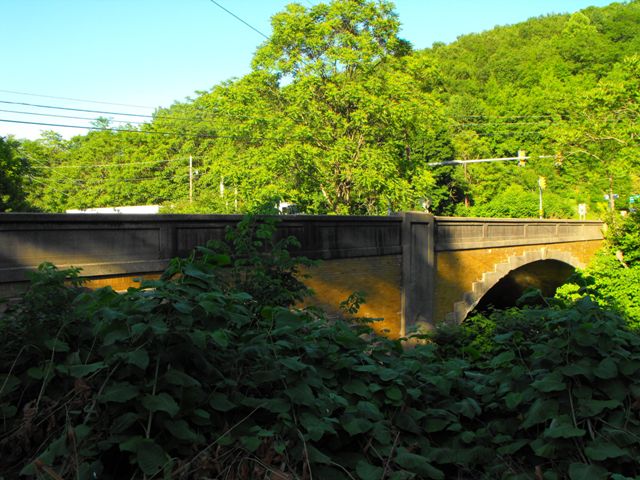We Recommend:
Bach Steel - Experts at historic truss bridge restoration.
BridgeHunter.com Phase 1 is released to the public! - Visit Now
Mt. Carbon Arch Bridge
Bridge Number 89

Primary Photographer(s): Nathan Holth and Rick McOmber
Bridge Documented: May 30, 2010 and November 2, 2019
Mt. Carbon Arch Road (PA-2015 / LR-140) Over Schuylkill River
Mt. Carbon: Schuylkill County, Pennsylvania: United States
1925 By Builder/Contractor: Charles E. Walton of Pottsville, Pennsylvania
Not Available or Not Applicable
71.0 Feet (21.6 Meters)
164.0 Feet (50 Meters)
24 Feet (7.32 Meters)
2 Main Span(s)
532015001001310

View Information About HSR Ratings
Bridge Documentation
Viewed from on the road, this two span concrete arch bridge would appear to be a traditional concrete arch bridge, perhaps overshadowed by its far more rare and historic companion bowstring which sits abandoned on the old road alignment next to this bridge.
However a view of the spandrel walls of this bridge reveals a beautiful and unique structure that should also be considered a historic bridge. Rather than a traditional solid concrete spandrel wall, the wall is covered in decorative yellow tiles and also has a defined concrete arch ring patterned like a stone arch bridge, having a stepped design with a keystone in the center.
Aside from the loss of some of the yellow tiles and minor spalling of the concrete arch ring, the bridge appears to retain near-perfect historic integrity and good structural integrity including original concrete paneled railings with plaque.
The integrity of the bridge as well as its unique architectural design and details distinguish this arch bridge as noteworthy and the bridge should be considered historic on those grounds.
The review for this bridge in the Historic Bridge Inventory which found the bridge ineligible for listing in the National Register of Historic Places (ie not historic) is troubling to say the least. First it seems to have a biased and subjective review of the bridge, declaring it not eligible for the National Register partly on the grounds of the opinion of the reviewer that this bridge's "attempt as an aesthetic bridge is not successful." Certainly, everyone is entitled to their opinion on whether aesthetic elements on a bridge are attractive or not, but the evaluation of a bridge's historic value should not be determined on the basis of one person's opinion of aesthetic elements on the bridge. The fact is that this bridge does contain unique aesthetic detailing and on that basis it has historic value. Whether the person evaluating the bridge happened to like the aesthetic details or not should be irrelevant. Finally, the comment that "large sections of the veneer have failed and spalled" appears to be largely untrue, at least for the south side of the bridge which was most visible during photo-documentation. Indeed, there is a scattering of missing tiles, but these could easily be replicated and reinstalled as part of a comprehensive preservation project. Long story short, enough of the tiles remain to convey the original design and aesthetic intent of the bridge's builder and as such the bridge should be considered historically significant.
Information and Findings From Pennsylvania's Historic Bridge InventoryDiscussion of Bridge The 2 span, 164'-long reinforced concrete deck arch bridge is finished with a glazed blond brick veneer, which is its most distinctive feature. The roadway and sidewalk are framed with paneled concrete balustrades. The end posts extend to stylized pilasters, and the arch rings are accented with scored voussoirs and a keystone. The attempt at an aesthetic bridge is not successful, and large sections of the veneer have failed and spalled. Neither the 1925 bridge nor its setting are historically or technologically significant. Discussion of Surrounding Area The bridge carries a 2 lane road with shoulders over the Schuylkill River in an area dominated by modern commercial and industrial development along both SR 61, which is to the east paralleling the river, and the Reading Blue Mountain & Northern RR, which crosses the road overhead to the west of this bridge. The area does not have historic district potential. The historically significant but abandoned King bowstring truss bridge is just upstream.Bridge Considered Historic By Survey: No |
This bridge is tagged with the following special condition(s): Unorganized Photos
![]()
Photo Galleries and Videos: Mt. Carbon Arch Bridge
2010 Bridge Photo-Documentation
Original / Full Size PhotosA collection of overview and detail photos. This gallery offers photos in the highest available resolution and file size in a touch-friendly popup viewer.
Alternatively, Browse Without Using Viewer
![]()
2010 Bridge Photo-Documentation
Mobile Optimized PhotosA collection of overview and detail photos. This gallery features data-friendly, fast-loading photos in a touch-friendly popup viewer.
Alternatively, Browse Without Using Viewer
![]()
2019 Additional Unorganized Photos
Original / Full Size PhotosA supplemental collection of photos that are from additional visit(s) to the bridge and have not been organized or captioned. This gallery offers photos in the highest available resolution and file size in a touch-friendly popup viewer.
Alternatively, Browse Without Using Viewer
![]()
2019 Additional Unorganized Photos
Mobile Optimized PhotosA supplemental collection of photos that are from additional visit(s) to the bridge and have not been organized or captioned. This gallery features data-friendly, fast-loading photos in a touch-friendly popup viewer.
Alternatively, Browse Without Using Viewer
![]()
Maps and Links: Mt. Carbon Arch Bridge
Coordinates (Latitude, Longitude):
Search For Additional Bridge Listings:
Bridgehunter.com: View listed bridges within 0.5 miles (0.8 kilometers) of this bridge.
Bridgehunter.com: View listed bridges within 10 miles (16 kilometers) of this bridge.
Additional Maps:
Google Streetview (If Available)
GeoHack (Additional Links and Coordinates)
Apple Maps (Via DuckDuckGo Search)
Apple Maps (Apple devices only)
Android: Open Location In Your Map or GPS App
Flickr Gallery (Find Nearby Photos)
Wikimedia Commons (Find Nearby Photos)
Directions Via Sygic For Android
Directions Via Sygic For iOS and Android Dolphin Browser
USGS National Map (United States Only)
Historical USGS Topo Maps (United States Only)
Historic Aerials (United States Only)
CalTopo Maps (United States Only)


